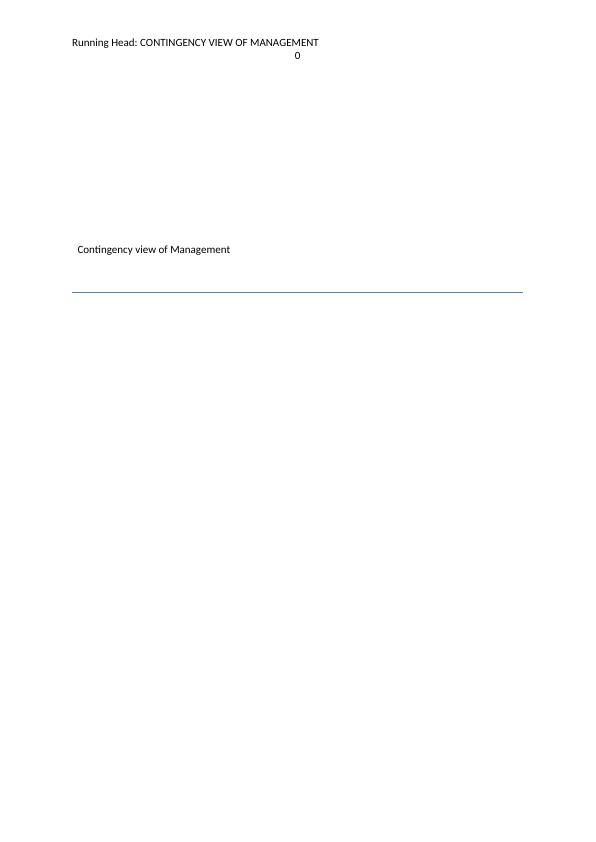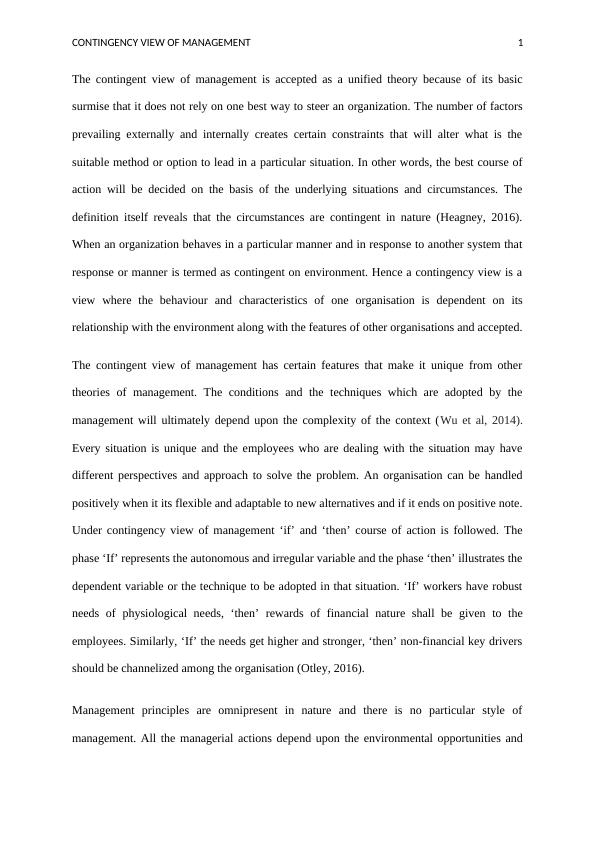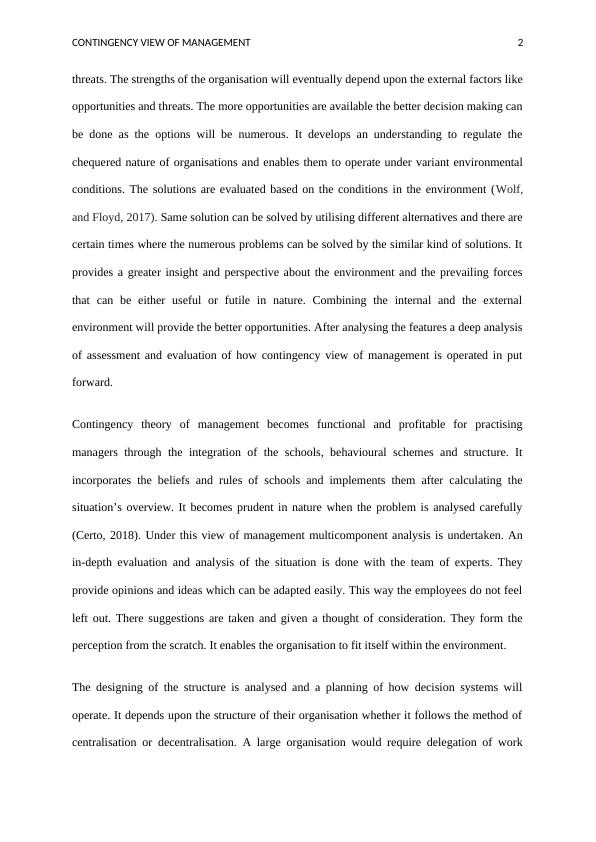Contingency View of Management
Added on 2023-06-14
8 Pages2149 Words311 Views
Running Head: CONTINGENCY VIEW OF MANAGEMENT
0
Contingency view of Management
0
Contingency view of Management

CONTINGENCY VIEW OF MANAGEMENT 1
The contingent view of management is accepted as a unified theory because of its basic
surmise that it does not rely on one best way to steer an organization. The number of factors
prevailing externally and internally creates certain constraints that will alter what is the
suitable method or option to lead in a particular situation. In other words, the best course of
action will be decided on the basis of the underlying situations and circumstances. The
definition itself reveals that the circumstances are contingent in nature (Heagney, 2016).
When an organization behaves in a particular manner and in response to another system that
response or manner is termed as contingent on environment. Hence a contingency view is a
view where the behaviour and characteristics of one organisation is dependent on its
relationship with the environment along with the features of other organisations and accepted.
The contingent view of management has certain features that make it unique from other
theories of management. The conditions and the techniques which are adopted by the
management will ultimately depend upon the complexity of the context (Wu et al, 2014).
Every situation is unique and the employees who are dealing with the situation may have
different perspectives and approach to solve the problem. An organisation can be handled
positively when it its flexible and adaptable to new alternatives and if it ends on positive note.
Under contingency view of management ‘if’ and ‘then’ course of action is followed. The
phase ‘If’ represents the autonomous and irregular variable and the phase ‘then’ illustrates the
dependent variable or the technique to be adopted in that situation. ‘If’ workers have robust
needs of physiological needs, ‘then’ rewards of financial nature shall be given to the
employees. Similarly, ‘If’ the needs get higher and stronger, ‘then’ non-financial key drivers
should be channelized among the organisation (Otley, 2016).
Management principles are omnipresent in nature and there is no particular style of
management. All the managerial actions depend upon the environmental opportunities and
The contingent view of management is accepted as a unified theory because of its basic
surmise that it does not rely on one best way to steer an organization. The number of factors
prevailing externally and internally creates certain constraints that will alter what is the
suitable method or option to lead in a particular situation. In other words, the best course of
action will be decided on the basis of the underlying situations and circumstances. The
definition itself reveals that the circumstances are contingent in nature (Heagney, 2016).
When an organization behaves in a particular manner and in response to another system that
response or manner is termed as contingent on environment. Hence a contingency view is a
view where the behaviour and characteristics of one organisation is dependent on its
relationship with the environment along with the features of other organisations and accepted.
The contingent view of management has certain features that make it unique from other
theories of management. The conditions and the techniques which are adopted by the
management will ultimately depend upon the complexity of the context (Wu et al, 2014).
Every situation is unique and the employees who are dealing with the situation may have
different perspectives and approach to solve the problem. An organisation can be handled
positively when it its flexible and adaptable to new alternatives and if it ends on positive note.
Under contingency view of management ‘if’ and ‘then’ course of action is followed. The
phase ‘If’ represents the autonomous and irregular variable and the phase ‘then’ illustrates the
dependent variable or the technique to be adopted in that situation. ‘If’ workers have robust
needs of physiological needs, ‘then’ rewards of financial nature shall be given to the
employees. Similarly, ‘If’ the needs get higher and stronger, ‘then’ non-financial key drivers
should be channelized among the organisation (Otley, 2016).
Management principles are omnipresent in nature and there is no particular style of
management. All the managerial actions depend upon the environmental opportunities and

CONTINGENCY VIEW OF MANAGEMENT 2
threats. The strengths of the organisation will eventually depend upon the external factors like
opportunities and threats. The more opportunities are available the better decision making can
be done as the options will be numerous. It develops an understanding to regulate the
chequered nature of organisations and enables them to operate under variant environmental
conditions. The solutions are evaluated based on the conditions in the environment (Wolf,
and Floyd, 2017). Same solution can be solved by utilising different alternatives and there are
certain times where the numerous problems can be solved by the similar kind of solutions. It
provides a greater insight and perspective about the environment and the prevailing forces
that can be either useful or futile in nature. Combining the internal and the external
environment will provide the better opportunities. After analysing the features a deep analysis
of assessment and evaluation of how contingency view of management is operated in put
forward.
Contingency theory of management becomes functional and profitable for practising
managers through the integration of the schools, behavioural schemes and structure. It
incorporates the beliefs and rules of schools and implements them after calculating the
situation’s overview. It becomes prudent in nature when the problem is analysed carefully
(Certo, 2018). Under this view of management multicomponent analysis is undertaken. An
in-depth evaluation and analysis of the situation is done with the team of experts. They
provide opinions and ideas which can be adapted easily. This way the employees do not feel
left out. There suggestions are taken and given a thought of consideration. They form the
perception from the scratch. It enables the organisation to fit itself within the environment.
The designing of the structure is analysed and a planning of how decision systems will
operate. It depends upon the structure of their organisation whether it follows the method of
centralisation or decentralisation. A large organisation would require delegation of work
threats. The strengths of the organisation will eventually depend upon the external factors like
opportunities and threats. The more opportunities are available the better decision making can
be done as the options will be numerous. It develops an understanding to regulate the
chequered nature of organisations and enables them to operate under variant environmental
conditions. The solutions are evaluated based on the conditions in the environment (Wolf,
and Floyd, 2017). Same solution can be solved by utilising different alternatives and there are
certain times where the numerous problems can be solved by the similar kind of solutions. It
provides a greater insight and perspective about the environment and the prevailing forces
that can be either useful or futile in nature. Combining the internal and the external
environment will provide the better opportunities. After analysing the features a deep analysis
of assessment and evaluation of how contingency view of management is operated in put
forward.
Contingency theory of management becomes functional and profitable for practising
managers through the integration of the schools, behavioural schemes and structure. It
incorporates the beliefs and rules of schools and implements them after calculating the
situation’s overview. It becomes prudent in nature when the problem is analysed carefully
(Certo, 2018). Under this view of management multicomponent analysis is undertaken. An
in-depth evaluation and analysis of the situation is done with the team of experts. They
provide opinions and ideas which can be adapted easily. This way the employees do not feel
left out. There suggestions are taken and given a thought of consideration. They form the
perception from the scratch. It enables the organisation to fit itself within the environment.
The designing of the structure is analysed and a planning of how decision systems will
operate. It depends upon the structure of their organisation whether it follows the method of
centralisation or decentralisation. A large organisation would require delegation of work

End of preview
Want to access all the pages? Upload your documents or become a member.
Related Documents
Using Numeracy and ICT Skills in Researchlg...
|8
|1649
|281
Using Numeracy and ICT Skills in Researchlg...
|7
|1308
|175
Essay On Management Theorieslg...
|6
|1375
|197
Using Numeracy and ICT Skills in Researchlg...
|7
|1187
|91
Leadership and Change Management: Impact on Employee Job Satisfaction and Organizational Obligation in the Construction Sector of UAElg...
|8
|2712
|376
Management and Leadership Objectiveslg...
|11
|3232
|278
